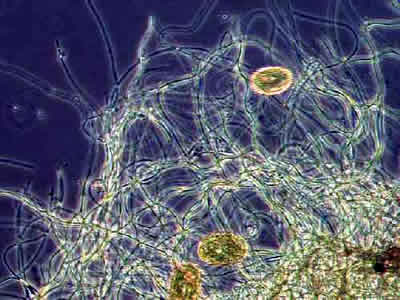What are cyanobacteria?
A class of photosynthetic bacteria
formerly referred to as "blue-green algae".
Cyanobacteria are prokaryotic oxygenic phototrophs that contain chlorophyll a and phycobilins. Some species of these photosynthetic prokaryotes can fix atmospheric nitrogen in a free-living state or in a symbiosis with plants known as Azolla [Becking,1978]. They are known to be tolerant of extreme conditions. Cyanobacteria were critical in the evolution of life. They were the first oxygenic phototrophs to evolve on Earth, producing oxygen on an originally anoxic environment. This paved the way for the evolution of organisms that could respire using oxygen.
Cyanobacteria comprise a large and morphologically heterogeneous group of phototrophic Bacteria. Both unicellular and filamentous forms with considerable variations are known to exist. Five morphological groups have been established, as seen in Table 1.
Cyanobacteria do not need vitamins to subsist. They can use nitrate or ammonia as a source of nitrogen, and also require phosphorus and micronutrients, such as iron. Most species are phototrophs, but some filamentous species can grow in the dark using sugar from glucose or sucrose as a carbon and energy source.
Structure
Cyanobacterial cells range in size from 0.5-1 μm to 40 μm in diameter. The cell wall structure is similar to that of a gram-negative bacterium [Gerba, Maier and Pepper, 2000]. Some cyanobacteria form a complex and multilayered photosynthetic membrane system composed of mucilaginous envelopes or sheaths that bind filaments or groups of cells together. Some filamentous cyanobacteria form heterocysts. These are rounded, seemingly empty cells that are generally distributed along a filament or at one end of the filament. Heterocysts are the single site for nitrogen fixation in heterocystous cyanobacteria.
Microbial mats in the Antarctic
Cyanobacteria occupy the upper region of microbial mats, where they can have more access to sunlight. A microbial mat is an interfacial aquatic habitat where many microbial groups are laterally compressed into a thin mat of biological activity. The photosynthetic activity of the cyanobacteria generates an oxygenic environment in the upper layer of the mat. Microbial mats are often found in extreme or highly fluctuating environments. The interdependent microbial components of the mat form clearly stratified and distinctively colored zones.
Microbial mats composed primarily of cyanobacteria, several species of pennate diatoms, and heterotrophic bacteria occur abundantly throughout much of the benthic regions of Lakes Bonney, Chad, Hoare, Fryxell, Joyce and Vanda in the McMurdo Dry Valleys. [Wharton et al., 1983; Parker and Wharton, 1985]. Most common cyanobacterial communities found in perennial streams are composed entirely of Oscillatoriaceae. The cohesive mats range in color from pink to orange, and are common in stable subtrates with flowing water. A second type of cyanobacterial mat is composed primarily of Nostoc commune, which form black mucilaginous layers at the edge of streams in the McMurdo Sound region.
Algal species in Taylor Valley
In the Antarctic lakes, ponds and streams cyanobacteria form extensive microbial mats, where members of the Oscillatoriaceae seem to be the most predominant. [Vincent, Downes, Castenholz and Howard-Williams, 1993] Fifteen morphotypes of the family Oscillatoriaceae were found to be present in Taylor Valley [Alger, 1997]. Other families of cyanobacteria were also identified [Alger, 1997].

Cyanobacteria in a colony. Photo: Cyanosite
Table 1. The cyanobacteria
| Group | Genera |
| I. Unicellular: single cells or cell aggregates. | Gloeothece, Gloeobacter, Synechococcus, Cyanothece, Gloeocapsa, Synechocystis, Chamaesiphon, Merismopedia |
| II. Pleurocapsalean: reproduce by formation of small spherical cells called baeocytes produced through multiple fission. | Dermocarpa, Xenococcus, Dermocarpella, Pleurocapsa, Myxosarcina, Chroococcidiopsis |
| III. Oscillatorian: filamentous cells that divide by binary fission in a single plane. | Oscillatoria, Spirulina, Arthrospira, Lyngbya, Microcoleus, Pseudanabaena |
| IV. Nostocalean: filamentous cells that produce heterocysts | Anabaena, Nostoc, Calothrix, Nodularia, Cylinodrosperum, Scytonema |
| V. Branching: cells divide to form branches. | Fischerella, Stignoema, Chlorogloeopsis, Hapalosiphon |
Madigan, Michael T., Martinko, John M. (2006) Brock Biology of Microorganisms. 11 ed. Pearson Prentice Hall. New Jersey, USA. p. 396

Dale Andersen collecting samples and making observations of the microbial mat community in Lake Hoare. Photo: Andersen Field Journal
Lake Hoare and others in the Dry Valleys are supersaturated with gases mainly as a result of the thick ice-cover. Above 11 meters, bubble formation occurs. This, in turn, causes large amounts of the microbial mat to tear lose from the bottom of the lake. Some of this material then floats to the underneath side of the ice-cover, is incorporated into the ice, and then is transported to the surface of the ice over a period of about 10 years. The now dry, frozen, mat may be transported via the wind to other locations. If the mat should happen to land in liquid water (during the summer months) the cells will rehydrate and begin to grow again if the necessary nutrients required for growth are available.
